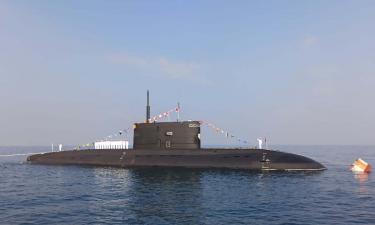Vladimir Ilyich Lenin – Part Two
 Lenin’s name is tainted though.
Lenin’s name is tainted though.
A greater portion of the world saw him as a maniacal dictator and mentoring his lap dog, Stalin, who would later become a homicidal butcher of unparallel proportions of the people he ruled over. More people died during the Red Terror than in World War One.
Lenin’s classless society became a society of the elite, and a society of everyone else whose life expectancy was measured 24 hours at a time. Anyone who was suspected of being counter-revolution was executed and at the helm was Lenin.
In America, both the US Government and American big business expressed fears about Lenin. Life in America was brutal for the common person. Wages were so low that entire families had to work just to earn enough to feed themselves. Children were sent to work in the mills producing yarn, cotton, and steel. Children died in those mills on a regular basis as they were sucked into machinery and they were ripped apart.
A man working for the mines was required to buy his clothing, working tools, food, and housing from the company at grossly exaggerated prices – and he sunk deeper and deeper into debt with no way out. He children were also put to work doing the most hazardous jobs such as bringing dynamite back and forth – if the dynamite exploded, the father had to pay for it. If the man was killed in a mining accident, his widow was expected to pay for the rescue attempt. To this day, no one knows how many bodies are still in the abandoned coal mines.
The 60 hour work week was the rule and if you made it to age 45, you were a very old person.
There were riots in America and frequently the riots were met with gun fire – taking terrible tolls of those who wanted nothing more than a better living condition and food. From the rat infested slums of America rose the cry for anarchy, and came the people who were willing to die to bring it about.
The American elite grew wealthier while the down trodden died. America, at least the government and high society saw nothing wrong with that either.
Substitute the word America to the word Russia and you will see the same pattern.
The words of Lenin came to this country through immigrants and books. The thought of a proletariat rule started appealing to the down trodden in America. A threat was now facing both the government and big business.
America responded to Lenin by introducing military into Siberia to fight hand in hand with the White Russians. Lenin could not be allowed to succeed. Japan was equally worried and they also sent troops into Russia.
Lenin could do no right in some American’s eyes – and they made sure that Lenin’s misdeeds were well known. The Russian revolution became synonymous with slaughter, betrayal, and rebellion against a lawful government.
The allies fighting against Germany needed Russia to stay in the war to occupy German forces while the allied governments swept in from the south and the west. Lenin had stabbed the allies in the back.
This is what the US saw in Lenin:
“Within six months, with a small band of faithful followers, he had stolen the legitimate fruits of the revolution, betrayed the working people of Russia, and established the greatest tyranny and dictatorship the world has ever known. The State and the Revolution which he was writing at that time is still considered a fundamental theoretical textbook. In it Lenin sets forth how the Communists are to come to power within the state, and what they must do once they are in power.
Lenin here concentrates upon the necessity of violence. He considers government the instrument by which the ruling class controls and exploits the subject class. All government is class government, and the institutions of a state such as the legislature, the executive, the judiciary, the police power, the tax power, and the educational institutions, are the instruments of the ruling class for the exploitation of the subjective class. According to Lenin's thesis, the governments of Europe and America were bourgeois governments which existed to exploit the people. These governments could be overthrown only through violence and bloodshed.
To Lenin the use of force and violence was not to be merely a reaction to force and violence used by the Capitalists. To him force was an instrument of positive purpose and he was totally devoid of any apologetic attitude towards its use. He states categorically that violence is essential to their purpose: "The suppression of the bourgeois state by the proletarian state is impossible without a violent revolution."
https://www.schwarzreport.org/yct/05ycttc.htm
The US was skeptical of the man who advocated violence as a means to an end. They saw in him an ugly, black hearted, ruthless demon who would stop at nothing to achieve his goals. The killing of the Tsar was seen as a barbaric act that had no basis, but, owing to Lenin’s character the one sided execution was no surprise.
American Foreign Policy Regarding the Russian Civil War
The United States sent units ofthe United States Army into Russia at a critical time Russian history. During the first months of the Russian Civil War, America sent three regiments to Northern Russia, to the Russian ports of Murmansk, Vladivostok and Archangelsk. These soldiers initially deployed to defend Russian interests, later assisted anti-Bolshevik forces in the area in several non-combatant ways.
When in November of 1917, the Bolsheviks seized power in Russia; the initial American response was immediate non-recognition of the new government. This was a concept initiated by President Wilson in which diplomacy took the standpoint of strict non-recognition. Under this principle, the United States extended its diplomatic recognition and blessing not upon the conventional theory of recognizing the new illegal government, but rather upon the impression of personal acceptance of the President. American foreign policy changed under this new principle since President Wilson did not approve of either the Bolsheviks or the manner by which they came to governmental power. As a result, the United States did not grant official diplomatic recognition to the new Soviet government.
However, the Bolsheviks, according to President Woodrow Wilson, were breaching the principle of self-determination. The U.S government publicly charged that the Bolsheviks were all representative of German Imperialism; this belief facilitated the U.S President to write off Lenin, Trotsky and the other leaders of the Soviet government as lawful products of the Russian Revolution.
On December 11, 1917, President Wilson reconsidered the Russian situation and decided to broaden America's assistance of anti-Bolshevik forces. On December 12, the Secretary of the U.S Treasury, William Gibbs McAdoo, was officially requested to supply the necessary funds. In 1918, and the United States physically intervened in the Russian Revolution.
Lenin and the Bolsheviks also deemed the peasants to be ‘the enemy’ and sought the destruction of those who, in reality, wanted to help. The blood letting took years to stop as Lenin moved Russia back into a dictatorial monarch made up of only him under the guise of socialism. From here sprung the secret police, the Checka, whose sole vile task was to root out those who might be counter revolutionary and to kill them by any means possible.
It is surprising that Lenin would denounce Stalin before a fatal stroke took his life – one wonders at the contradictions because it was Lenin who groomed Stalin, it was Lenin who showed Stalin that one had to rule through terror. Or did Lenin secretly whisper, “Oh God, what have I done to Russia?”. We will never know.
Lenin took Russia from a monarchy to a dictatorship, and the Russian people were worse off than they were before – which is the most frequent outcome of all revolutions, no matter what idealism was the cause. The outcome is usually uglier than the yesterdays. The death toll staggers the mind.
I have talked with people who lived through the revolution. Still, even after all these years, tears come to their eyes when they recall loved ones and friends who died for no other reason except for the fact they were Russians. Pawns in a sea of death that knew no boundaries or nationalities.
Russia’s past had been stripped from the land and when destroys the past, one also destroys the future. We, in America, watched the news reels of the May Day parades, of the celebrations in Red Square – but today, we find that it was all force levity at the point of a gun. There was no workers paradise.
Russia is plagued with drugs and alcoholism today. Prostitution, that which I saw in Moscow, is the only life many young girls will ever know. Everywhere I went, a majority of people said there are only problems, and no sunshine to be seen. A questioning people wandering in a black forest of jaded history.
There are people who want the strong communist government Russia had under Stalin. They do not know the price Russia paid for the October revolution – that price is now evident and one sees it in the homeless people living in the railway stations of Moscow. Of the people who still look over their shoulder before they speak. Of the people who still walk with their eyes cast upon the ground lest anyone see their emotions.
This is Lenin’s legacy, this is what he gave to Russia, and this is what he left Russia with. Only after he gained power did his true self emerge – a bitter and angry man, filled with hatred for his country, his people, and his government. And he insured that when he died, Russia died with him.
The worker’s paradise that was promised was, and is, in all actuality, Russia's funeral pyre.
Subscribe to Pravda.Ru Telegram channel, Facebook, RSS!




